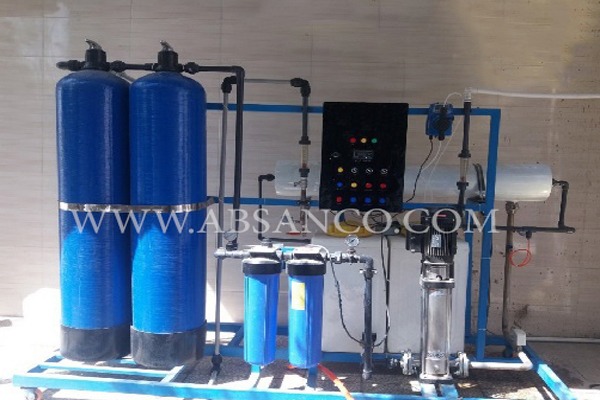Package RO Plant
Reverse osmosis (RO) membrane technology is widely recognized to offer the most effective and economical process options currently available. From small scale systems (5m3/d), through to very large scale desalination (over 500 m3/d), RO can handle most naturally occurring sources of brackish and seawaters. Permeate waters produced satisfy most currently applicable standards for the quality of drinking or industrial waters
RO can reduce regeneration costs and waste when used independently, in combination or with other processes, such as ion exchange
An entire reverse osmosis (RO) water treatment system consists of the pretreatment section, the membrane element section, and the post-treatment section. Pretreatment equipment such as sand filter, activated carbon filter, microfilter and/or ultrafilter. Post-treatment is employed to achieve the required product quality. In seawater desalination, this is usually pH adjustment, rehardening and disinfection. In ultrapure water (UPW) production, the permeate is usually post-treated by polishing ion exchange demineralization

Definition of Osmotic Pressure
Where two solutions having different solute concentrations are separated by a semipermeable membrane, a difference in chemical potential will exist across the membrane. Water will tend to diffuse through the membrane from the lower-concentration (higher-potential) side to the higher-concentration (lower-potential) side. In effect, the water passing through the membrane is trying to dilute the higher ionic concentration solution to equalize the concentrations on both sides of the membrane.
This balancing pressure difference is termed the osmotic pressure, and is a function of the solute characteristics and concentration and temperature. If a pressure gradient opposite in direction and greater than the osmotic pressure is imposed across the membrane, flow from the more concentrated to the less concentrated region will occur and is termed reverse osmosis. The principle of RO is employed in both the NF and RO processes.

Nanofiltration and Reverse Osmosis
Nanofiltration and RO unlike MF and UF, are capable of separating dissolved ions from the feed stream. MF and UF use pressure (and sometimes a vacuum) to provide convective flow of the liquid through the membrane, and NF and RO require hydrostatic pressure to overcome the osmotic pressure of the feed stream. Whereas MF and UF membranes reject constituents based on size and are rated in terms of pore size or porosity, NF and RO membranes are rated on the basis of salt rejection and flow. NF and RO can remove particles of sizes less than 10_۲ μm, which encompass dissolved and colloidal material such as aqueous salts, organic matter, pesticides, and herbicides.
In concept and operation, NF is much the same as RO; the key difference is the degree of removal of monovalent ions such as sodium and chlorides. Reverse osmosis removes monovalent ions in the 98 to 99+ percent range while removals with NF membranes vary between 50 and 90 percent, depending on the material and manufacture of the membrane. Nanofiltration has often been incorrectly categorized as a “loose RO” membrane.
Nanofiltration has the ability to reject uncharged, dissolved materials and positively charged ions according the size and shape of the molecule. In contrast, “loose RO”—sometimes called low-pressure RO, is an RO membrane with reduced salt rejection. This type of membrane has been used in applications where moderate salt removal is acceptable.
Reverse osmosis has been used in many applications including sea and brackish water desalination and industrial process water for the removal of dissolved constituents.
Reverse osmosis typically removes 95 to 99.5 percent of the total dissolved solids and 95 to 97 percent of dissolved organic matter. With the development of new low-pressure membranes, RO is finding increased use for water reuse applications.
REVERSE OSMOSIS
Reverse osmosis is used to remove dissolved materials, commonly salts, under pressures ranging from 1200 to 1800 kPa for low TDS water (1000 to 2500 mg/L) to 5500 to 8500 kPa for seawater and at flux rates varying from about 12 to 200 L/m2.h. Separation using RO membranes is effective generally at solute molecular weights below 300, and related solute sizes from 0.0001 to 0.001 μm (Celenza, 2000)
Pretreatment
Membrane elements in NF and RO units can be fouled by colloidal matter and other constituents in the feed stream. For example, certain chemical constituents in the feed stream can increase membrane fouling because they are at or near their solubility limits and can precipitate, especially in RO applications. In most cases, pretreatment is absolutely necessary to remove or reduce these constituents. Several pretreatment options have been used singly or in combination. Appropriate forms of pretreatment include depth or surface filtration, MF or UF, dissolved air flotation, and cartridge filters.
Cartridge filters, are almost always used as a further pretreatment step, both with reclaimed water as well as untreated seawater, following one or more of the pretreatment options cited above. Cartridge filters serve two important purposes: (1) as an inexpensive secondary barrier in the event of a failure in the pretreatment system and (2) to remove any particulate impurities originating from the chemicals added to precondition the feed water to the NF, RO, or EDR membranes.
Common chemical pretreatments include pH adjustment, constituent precipitation, and the use of antiscalants. In some cases, dechlorination might be required to protect the membranes. It is important to note that the highest grade of chemicals (i.e., food grade) are not used typically. Often, the chemicals added to the feed stream will contain particulate matter that must be removed to avoid damaging the membranes. For example, sulfuric acid used to lower the pH of the feed stream will often contain particulate matter that can be damaging to most membranes. Thus, as noted above, cartridge filters are used to protect against the presence of chemical impurities.
Ask us how our equipment can help you and your industry
Contact us at: Phone N.O 00983136516429 Fax: 00983136518981 WhatsApp: 00989103592006
۳ & ۴-sealed Gates- Sanitary Wastewater Treatment Package- Oil Remover- Water Desalination- Sludge Scrapper Bridge


